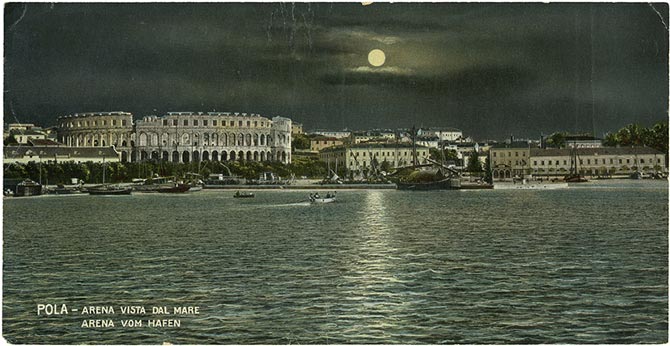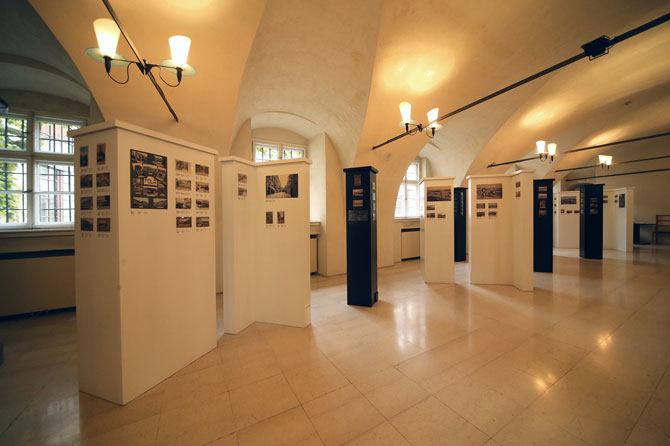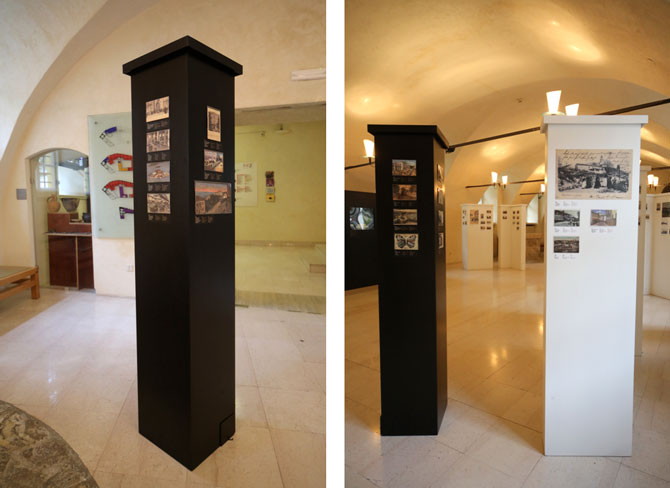Istra Istria Memento – a selection from the Old Postcards Collection
Historical and Maritime Museum of Istria – Museo storico e navale dell’Istria, guest appearance in Zagreb City Museum
Exhibition concept: Gordana Milaković
Exhibition and poster design: Sanja Pecirep
Coordinator: Dubravka Zaninović Stančec, ZCM
.jpg) With our exhibition Istra Istria Memento – a selection from the Old Postcards Collection we present to the public, for the first time, a portion of the exceptionally rich holdings of one of the largest collections, both in number and in substance, of the Historical and Maritime Museum of Istria – Museo storico e navale dell'Istria. The Old Postcards Collection was set up in 1991 and, thanks to a carefully planned and successfully realized purchasing policy, the Museum presently owns about 14,000 postcards dating from late 19th century to the 1970s that are geographically and thematically related to Istria.
With our exhibition Istra Istria Memento – a selection from the Old Postcards Collection we present to the public, for the first time, a portion of the exceptionally rich holdings of one of the largest collections, both in number and in substance, of the Historical and Maritime Museum of Istria – Museo storico e navale dell'Istria. The Old Postcards Collection was set up in 1991 and, thanks to a carefully planned and successfully realized purchasing policy, the Museum presently owns about 14,000 postcards dating from late 19th century to the 1970s that are geographically and thematically related to Istria.
On 1st October 1869 the Viennese postal authority issued the first official postcard entitled Correspondenz-Karte and we are proud to present it in our collection – such a card was mailed from Pula as early as 24th October 1869! The bulk of the Collection consists of postcards printed during the golden age of postcards (1897–1918), characterized by a variety of motifs and a superior print quality. The earliest postcards were printed by the use of lithography, chromolithography and xylography techniques. Later on, photolithography was also common. These techniques enabled high-quality reproduction of the original design, but they also required much effort and manual work in painting and preparation of each individual card. Consequently, they can be considered to be small works of art.
Until the late 19th century German lithography workshops were the leading workshops in the world, both in quality and price, and the most important printing centres were Leipzig, Dresden, Berlin, Frankfurt, Nuremberg and Munich. The Old Postcards Collection holds a number of postcards with Istrian themes that have been published by the most famous German publishers such as Stengel & Co., Markert & Sohn (Dresden), the renown Dr. Trenkler & Co., Louis Glaser (Leipzig), Purger & Co. (Dresden) and others.

 The first Pula postcard publishers appeared by the end of the 19th century (A. Bonetti, M. Fischer, M. Clapis, F. W. Schrinner, G. Fano, G. Costalunga, Rudolf Marincovich, Josip Krmpotić) and until the 1920s they printed their postcards, of equally good quality as their European counterparts, in large print runs and of great thematic diversity. At the same time, two Pula photographic ateliers – Flora and Ideal – printed their postcards based on their own photographic templates.
The first Pula postcard publishers appeared by the end of the 19th century (A. Bonetti, M. Fischer, M. Clapis, F. W. Schrinner, G. Fano, G. Costalunga, Rudolf Marincovich, Josip Krmpotić) and until the 1920s they printed their postcards, of equally good quality as their European counterparts, in large print runs and of great thematic diversity. At the same time, two Pula photographic ateliers – Flora and Ideal – printed their postcards based on their own photographic templates.
As early as the first decade of the 20th century almost every Istrian town or village had its own postcard publisher printing a wide array of postcards, such as Josip Novak and Pasquale Ivich (Pazin), Federico Greatti, Adolfo Vicich and Giacomo Greatti (Poreč), Nicolo Daveggia and Giovanni Signori (Rovinj), Gius. Picciola and Antonia V. Parreto (Umag), Luigi Parentin and Carlo Verginella (Novigrad), Giorgio Rottini and Maria Fabiani (Buzet), Antionio Tagliapietra (Buje), T. Vladislovich and G. Valcini (Labin). Postcards with Istrian motifs were also printed by numerous Italian publishers such as Vittorio Stein (Trieste and Venice), I. Stein (Trieste), G. Stokel & Debarba (Trieste), A. Cadel (Trieste), Cesare Capello (Milano) and others.
The Old Postcards Collection includes, in territorial sense, postcards that thematically refer to that part of the Istrian territory that constitutes Istria as a geographical unit, a territory which is today divided among three states – Croatia, Slovenia and Italy. It was precisely the territorial representation that constituted the basis for this exhibition and so every city, town and village whose postcard the Museum has in its holdings, is represented by at least one postcard. The units of the exposition are: Pula and its surroundings, Pazin and its surroundings, Buzet and its surroundings, Rovinj and its surroundings, Poreč and its surroundings, Buje and its surroundings, Muggia, Koper and its surroundings, Labin and its surroundings, Liburnija and the islands. The motifs on the displayed postcards are mostly panoramas, views, street and village scenes. The Old Postcards Collection holds an innumerable variety of motifs, because there is almost no subject that was not pictured on a postcard, in countless variations.






Postcards constitute museum material of exceptional value; they are a distinctive visual memento of social reality. They are an important source for the study of social, cultural and economic history, ethnology, history of urban planning and architecture, conservation and restoration work, protection of monuments and history of language.
Gordana Milaković
Pictures from the exhibition






photo Miljenko Gregl, ZCM

